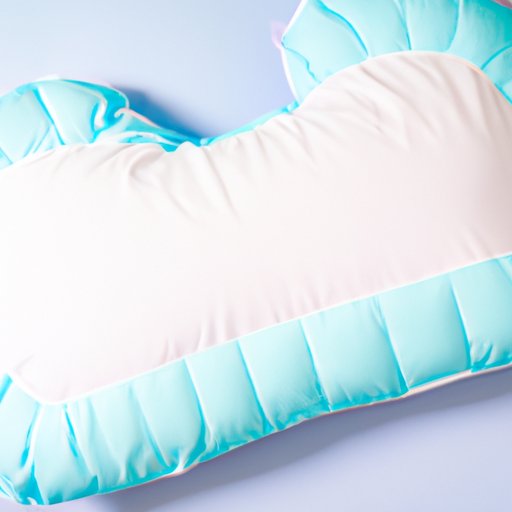
Introduction
Pregnancy can be an exciting and overwhelming time for expectant mothers, and it often comes with physical discomfort that can interfere with sleep. A pregnancy pillow can make all the difference in getting a good night’s rest. In this article, we’ll explore the benefits of using a pregnancy pillow, the different types available, how to use them, and tips and tricks for maximum comfort.
Benefits of using pregnancy pillows
During pregnancy, the body undergoes tremendous changes that can cause discomfort. A pregnancy pillow can help improve comfort by providing support and adjusting to your body’s contours. The benefits of using a pregnancy pillow include:
- Alleviating back pain
- Improving blood circulation
- Preventing complications during sleep, such as snoring and sleep apnea
- Relieving pressure points
- Supporting the belly and hips
Pregnancy pillows can also be particularly helpful during different trimesters when different parts of the body may require additional support or elevation, such as the third trimester when back pain and sleeplessness are the most common.
Types of pregnancy pillows
There are several types of pregnancy pillows to choose from, each with its own features and sizes:
Wedge Pillows
Wedge pillows are small, triangular-shaped pillows that provide gentle support under the belly, back, or neck. They’re ideal for women who prefer sleeping on their back, as they can help alleviate pressure on the lower back.
C-Shaped Pillows
C-Shaped pillows are larger pillows that wrap around the body, providing support for the head, neck, back, and hips. They’re ideal for side-sleepers, especially during the third trimester when additional support is needed.
U-Shaped Pillows
U-Shaped pillows are like C-shaped pillows but with an extra side that provides support for both the back and belly simultaneously. They’re ideal for women who toss and turn during the night or need support for both sides of the body.
When choosing a pregnancy pillow, consider your sleeping habits and which parts of your body need the most support. It’s also essential to find a pillow that feels comfortable and isn’t too hot or too firm.
How to use a pregnancy pillow
The position in which you sleep may change during pregnancy, and using a pregnancy pillow can help accommodate these changes. Here’s how to use a pregnancy pillow in different sleeping positions:
Side Sleeping
Side-sleeping is the most recommended sleeping position during pregnancy. Here’s how to use a pregnancy pillow for optimal comfort:
- Start by lying on your side with the pillow between your legs.
- Place the bottom end of the pillow under your belly and pull it up towards your chest.
- Adjust the top end of the pillow to support your head and neck
- Place your arm in front of the pillow for support.
Back Sleeping
Sleeping on your back during pregnancy is not advised, but if it happens, a pregnancy pillow can provide support and alleviate pressure on the lower back:
- Place the pillow beneath your knees, and another one under your head and neck.
- Use a wedge pillow for support under your back as well.
Stomach Sleeping
Sleeping on your stomach during pregnancy can be uncomfortable, but if you’re used to it, a pregnancy pillow can help provide support:
- Place the pillow beneath your hips.
- Use another pillow for support under your head and neck.
- Support your growing belly with a wedge pillow.
Adjusting the position and firmness of the pillow can also improve comfort and support, and getting feedback from other mothers can also be used to find the most comfortable position. Many pregnant women find that using a pregnancy pillow helps them sleep better, although they sometimes need to experiment with different positions before finding what works best.
Tips and tricks for using pregnancy pillows
Here are a few additional tips and tricks to get the most out of using a pregnancy pillow:
Combine with other pillows for additional support
Depending on your sleeping needs, you may find that combining different types of pillows can improve your comfort. For example, combining a wedge pillow with a C-shaped pillow can provide both back and belly support.
How to clean and maintain the pillow, and whether it’s safe for both mother and baby
It’s essential to read and follow the manufacturer’s instructions on how to clean and maintain your pillow properly. Most don’t allow for machine washing, so it’s usually recommended to spot-clean using mild detergent and warm water. Always ensure that the pillow is entirely dry before usage, and avoid using harsh chemicals or bleach. Also, ensure that the pillow is made from materials that are safe, breathable, and non-toxic and that it doesn’t have any loose filling or detachable parts that can pose a choking hazard.
Suggestions for getting the most out of using a pregnancy pillow to improve sleep quality
Here are a few final suggestions for getting the most out of using a pregnancy pillow to improve sleep quality:
- Warm baths before bedtime can help relax muscles and prepare the body for sleep.
- Regular exercise or gentle yoga can improve overall comfort and promote healthy sleeping habits.
- Elevating your feet using a cushion or pillow can help ease swelling and improve comfort.
Conclusion
A pregnancy pillow can be a valuable tool for expectant mothers, helping to ease pain and discomfort and improve sleep quality. By considering your sleeping habits and needs, choosing the right type of pillow, and following our tips and tricks, you’ll be well on your way to getting a good night’s rest. Remember, it’s crucial to prioritize sleep during pregnancy, as it plays a vital role in maintaining your overall health, both physically and mentally.





